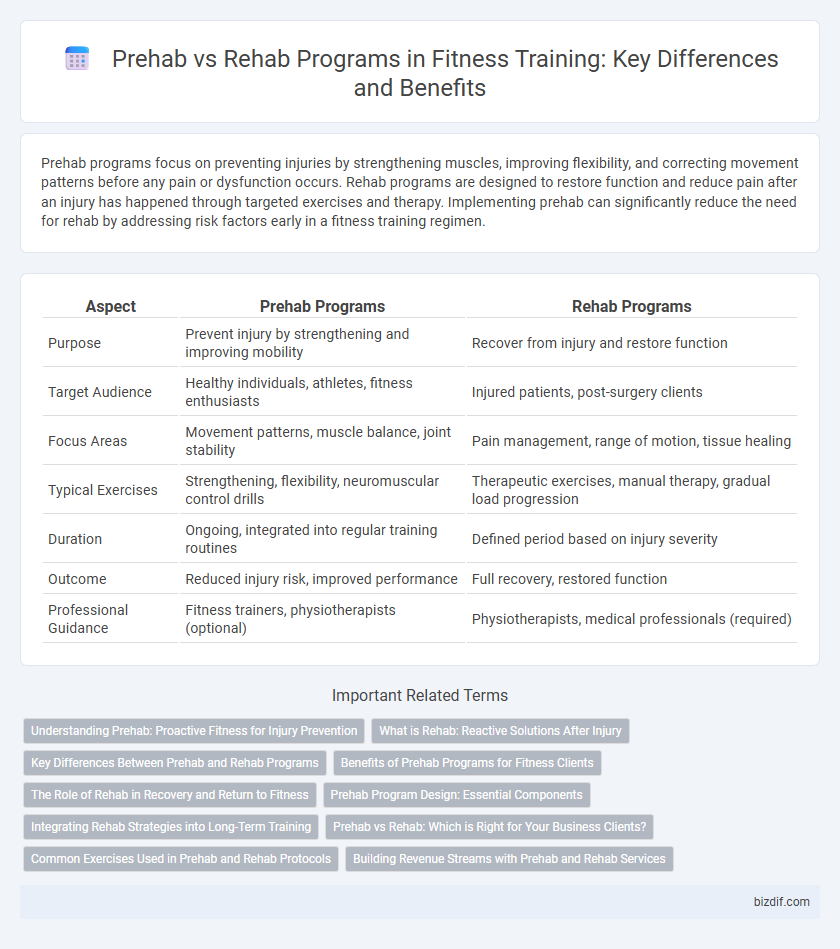Prehab programs focus on preventing injuries by strengthening muscles, improving flexibility, and correcting movement patterns before any pain or dysfunction occurs. Rehab programs are designed to restore function and reduce pain after an injury has happened through targeted exercises and therapy. Implementing prehab can significantly reduce the need for rehab by addressing risk factors early in a fitness training regimen.
Table of Comparison
| Aspect | Prehab Programs | Rehab Programs |
|---|---|---|
| Purpose | Prevent injury by strengthening and improving mobility | Recover from injury and restore function |
| Target Audience | Healthy individuals, athletes, fitness enthusiasts | Injured patients, post-surgery clients |
| Focus Areas | Movement patterns, muscle balance, joint stability | Pain management, range of motion, tissue healing |
| Typical Exercises | Strengthening, flexibility, neuromuscular control drills | Therapeutic exercises, manual therapy, gradual load progression |
| Duration | Ongoing, integrated into regular training routines | Defined period based on injury severity |
| Outcome | Reduced injury risk, improved performance | Full recovery, restored function |
| Professional Guidance | Fitness trainers, physiotherapists (optional) | Physiotherapists, medical professionals (required) |
Understanding Prehab: Proactive Fitness for Injury Prevention
Prehab programs emphasize proactive fitness strategies designed to strengthen muscles, improve flexibility, and enhance joint stability, effectively reducing the risk of injury before it occurs. These programs integrate targeted exercises and corrective movements that address individual imbalances and weaknesses, optimizing functional performance and resilience. In contrast to rehab programs, which focus on recovery after injury, prehab prioritizes preventative conditioning to maintain long-term musculoskeletal health and minimize downtime.
What is Rehab: Reactive Solutions After Injury
Rehab programs are reactive solutions designed to restore function and reduce pain following an injury by targeting specific muscle imbalances and joint limitations. These programs emphasize controlled exercises, manual therapy, and progressive loading to rebuild strength, flexibility, and mobility. Rehabilitation protocols prioritize injury recovery timelines and aim to prevent further damage while gradually reintroducing physical activity.
Key Differences Between Prehab and Rehab Programs
Prehab programs focus on injury prevention by enhancing strength, flexibility, and mobility before any injury occurs, using targeted exercises and movement assessments. Rehab programs, on the other hand, aim to restore function and reduce pain after injury by following structured recovery protocols, often guided by physical therapists. Key differences include timing, goal orientation, and the specific interventions used, with prehab emphasizing proactive conditioning and rehab concentrating on reactive healing and rehabilitation.
Benefits of Prehab Programs for Fitness Clients
Prehab programs enhance muscular strength, joint stability, and flexibility, reducing the risk of injuries during intensive fitness training. By identifying and addressing movement imbalances early, prehab increases overall performance and workout efficiency for fitness clients. This proactive approach minimizes downtime and promotes long-term physical resilience, distinguishing it from traditional rehab focused on recovery after injury.
The Role of Rehab in Recovery and Return to Fitness
Rehab programs play a critical role in recovery by addressing injury rehabilitation through targeted therapy that restores strength, flexibility, and function. These programs focus on healing damaged tissues and correcting movement patterns to prevent further injury while gradually reintroducing physical activity. Effective rehabilitation ensures a safe return to fitness by optimizing recovery timelines and reducing the risk of recurring injuries.
Prehab Program Design: Essential Components
Prehab program design focuses on injury prevention through targeted mobility exercises, strength training, and functional movement patterns tailored to individual needs. Emphasizing muscle imbalances, joint stability, and neuromuscular control, these programs integrate dynamic warm-ups, corrective drills, and progressive overload to enhance performance and reduce injury risk. Essential components include personalized assessments, proper technique coaching, and continuous monitoring to adapt exercises and ensure long-term musculoskeletal health.
Integrating Rehab Strategies into Long-Term Training
Integrating rehab strategies into long-term fitness training enhances injury prevention and performance longevity by bridging prehab and rehab programs. Prehab programs emphasize proactive strengthening and mobility exercises to minimize injury risks, while rehab targets recovery and restoring function post-injury. Combining these approaches creates a continuous cycle of assessment, correction, and progression, optimizing musculoskeletal health and athletic resilience over time.
Prehab vs Rehab: Which is Right for Your Business Clients?
Prehab programs focus on injury prevention and enhancing functional movement before issues arise, reducing downtime and healthcare costs for business clients. Rehab programs concentrate on recovery and restoring mobility post-injury, ensuring clients regain strength and avoid chronic complications. Choosing between prehab and rehab depends on client needs, but integrating prehab can lead to long-term wellness and decreased injury rates in workplace fitness initiatives.
Common Exercises Used in Prehab and Rehab Protocols
Prehab programs emphasize proactive exercises such as glute bridges, bodyweight squats, and resistance band lateral walks to strengthen muscles and improve joint stability before injury occurs. Rehab programs incorporate similar movements but often include progressive loading, controlled range-of-motion exercises, and neuromuscular re-education tailored to injury recovery phases. Both protocols prioritize functional movement patterns, but rehab exercises are typically more customized with therapeutic modalities to promote tissue healing and restore mobility.
Building Revenue Streams with Prehab and Rehab Services
Prehab programs proactively reduce injury risks, attracting clients seeking preventative care, while rehab programs address recovery needs, expanding service offerings for long-term client retention. Integrating both services enhances revenue streams by appealing to a broader market, from fitness enthusiasts to injury patients. Leveraging targeted marketing and specialized staff certifications in prehabilitation and rehabilitation drives higher client engagement and optimized profitability in fitness training facilities.
Prehab Programs vs Rehab Programs Infographic

 bizdif.com
bizdif.com